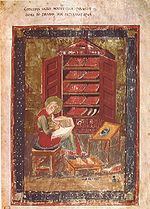Hauptwerke der angelsächsischen Buchmalerei
Hauptwerke der angelsächsischen Buchmalerei sind Darstellungen in Handschriften, die vom 7. bis zum 11. Jahrhundert in England entstanden.
| Abbildung | Bezeichnung | Entstehungszeit | Entstehungsort | Anmerkungen | Signatur |
|---|---|---|---|---|---|
 | Durham-Evangeliar (A.II.10) | um 650 | wahrscheinlich Kloster Lindisfarne | Evangeliar | Durham Cathedral Library, Manuscript A.II.10. |
 | Durham-Evangeliar (A.II.17) | um 680 | Kloster Lindisfarne oder Kloster Rathmelsigi, Irland | Evangeliar | Durham Cathedral Library, MS A II 17 |
 | Codex Amiatinus | um 700 | Kloster Monkwearmouth-Jarrow | Bibel, älteste erhaltene Vulgatahandschrift der Welt | Florenz, Biblioteca Laurenziana, MS Amiatinus 1 |
 | Lindisfarne-Evangeliar | 715/21 | Kloster Lindisfarne | Evangeliar; Schreiber und Illuminator: Eadfrith, Mönch und Bischof von Lindisfarne | London, British Library, Cotton MS Nero D. iv |
 | Cassiodor, Expositio psalmorum | um 730 | wahrscheinlich Kloster Monkwearmouth-Jarrow | Psalmenkommentar, älteste erhaltene Abschrift des spätantiken Werks | Durham, Cathedral Library, MS B. II. 30 |
| Beda Venerabilis, Historia ecclesiastica gentis Anglorum (L) | zwischen 731 und 746 | Kloster Monkwearmouth-Jarrow | Englische Kirchengeschichte, eine der beiden ältesten erhaltenen Abschriften | Sankt Petersburg, Russische Nationalbibliothek, lat. Q. v. I. 18 | |
 | Codex Aureus von Stockholm | um 750 | Schule von Canterbury | Evangeliar | Stockholm, Kungliga Biblioteket, MS.A.135 |
 | Vespasian-Psalter | zweite Hälfte des 8. Jahrhunderts | Abtei St. Augustinus Canterbury oder Abtei Minster-in-Thanet | Psalter (Psalmen) mit altenglischen Interlinearglossen, älteste englische Bibelübersetzung | London, British Library, Cotton Vespasian A I |
 | Book of Cerne | 9. Jahrhundert | Evangeliar | Cambridge University Library, MS L1. 1. 10 | |
| Evangeliar (London) | 10. Jhd. (Ergänzungen) | Winchester-Stil | Evangeliar mit angelsächsischen Evangelisten-Porträts in einer irischen Handschrift aus dem 8. Jahrhundert | British Library, MS 40618 | |
 | Benediktionale des heiligen Æthelwold | um 970/980 | Winchester | Benediktionale | British Library, MS 49598 |
 | Codex Junius (Caedmon) | um 1000 | Poem über die Genesis und neutestamentliche Erzählungen, eine der vier ältesten Handschriften in altenglischer Sprache | Oxford, University, Bodleian Library, MS Junius 11 | |
 | Grimbald-Evangeliar | Anfang des 11. Jahrhunderts | Winchester-Stil | Evangeliar | British Library, Add MS 34890 |
 | Regularis Concordia | 11. Jahrhundert | wahrscheinlich Winchester | Benediktiner-Regel | London, British Library, Cotton MS Tiberius A III |
 | Hexateuch (Claudius) | um 1025/1050 | Abtei St. Augustinus Canterbury | Älteste erhaltene altenglische Übertragung der ersten sechs Bücher der Bibel | London, British Library, Cotton MS Claudius B.iv |
Literatur
- Carl Nordenfalk: Celtic and Anglo-Saxon Painting: Book illumination in the British Isles 600–800. George Braziller, New York 1976, ISBN 978-0-8076-0825-8.
Auf dieser Seite verwendete Medien
Folio 5r from the Codex Amiatinus (Florence, Biblioteca Medicea Laurenziana, MS Amiatinus 1), Ezra the scribe. "When the sacred books had been consumed in the fires of war, Ezra repaired the damage."
King Edgar seated between St. Æthelwold, Bishop of Winchester, and St. Dunstan, Archbishop of Canterbury. From an eleventh-century manuscript of the Regularis Concordia. British Library MS Cotton Tiberius A iii.













